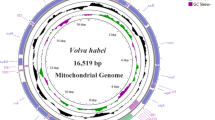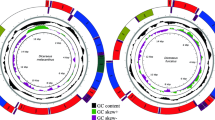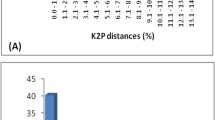Abstract
The monophyletic group Caniformia in the order Carnivora currently comprises seven families whose relationships remain contentious. The phylogenetic positions of the two panda species within the Caniformia have also been evolutionary puzzles over the past decades, especially for Ailurus fulgens (the red panda). Here, new nuclear sequences from two introns of the β-fibrinogen gene (β-fibrinogen introns 4 and 7) and a complete mitochondrial (mt) gene (ND2) from 17 caniform representatives were explored for their utilities in resolving higher-level relationships in the Caniformia. In addition, two previously available nuclear (IRBP exon 1 and TTR intron 1) data sets were also combined and analyzed simultaneously with the newly obtained sequence data in this study. Combined analyses of four nuclear and one mt genes (4417 bp) recover a branching order in which almost all nodes were strongly supported. The present analyses provide evidence in favor of Ailurus fulgens as the closest taxon to the procyonid-mustelid (i.e., Musteloidea sensu stricto) clade, followed by pinnipeds (i.e., Otariidae and Phocidae), Ursidae (including Ailuropoda melanoleuca), and Canidae, the most basal lineage in the Caniformia. The potential utilities of different genes in the context of caniform phylogeny were also evaluated, with special attention to the previously unexplored β-fibrinogen intron 4 and 7 genes.
Similar content being viewed by others
References
S.F. Altschul T.L. Madden A.A. Schäffer J. Zhang Z. Zhang W. Miller D.J. Lipman (1997) ArticleTitleGapped BLAST and PSI-BLAST: a new generation of protein database search programs Nucleic Acids Res. 25 3389–3402 Occurrence Handle9254694 Occurrence Handle1:CAS:528:DyaK2sXlvFyhu7w%3D Occurrence Handle10.1093/nar/25.17.3389
U. Arnason B. Widegren (1986) ArticleTitlePinniped phylogeny enlightened by molecular hybridizations using highly repetitive DNA Mol. Biol. Evol. 3 356–365 Occurrence Handle1:CAS:528:DyaL28XkvFansr4%3D
U. Arnason C. Ledje (1993) The use of highly repetitive DNA for resolving cetacean and pinniped phylogenies F.S. Szalay M. Novacek McKenna (Eds) Mammal Phylogeny Springer-Verlag NY
U. Arnason J.A. Adegoke K. Bodin E.W. Born Y.B. Esa A. Gullberg M. Nilsson R.V. Short X. Xu A. Janke (2002) ArticleTitleMammalian mitogenomic relationships and the root of the eutherian tree Proc. Natl. Acad. Sci. USA 99 8151–8156 Occurrence Handle12034869 Occurrence Handle1:CAS:528:DC%2BD38XkvVGisLc%3D Occurrence Handle10.1073/pnas.102164299
F.K. Barker (2004) ArticleTitleMonophyly and relationships of wrens (Aves: Troglodytidae): a congruence analysis of heterogeneous mitochondrial and nuclear DNA sequence data Mol. Phylogenet. Evol. 31 486–504 Occurrence Handle15062790 Occurrence Handle1:CAS:528:DC%2BD2cXivVKntLs%3D Occurrence Handle10.1016/j.ympev.2003.08.005
O.R.P. Bininda-Emonds J.L. Gittleman A. Purvis (1999) ArticleTitleBuilding large trees by combining phylogenetic information: a complete phylogeny of the extant Carnivora (Mammalia) Biol. Rev. 74 143–175 Occurrence Handle10396181 Occurrence Handle1:STN:280:DyaK1MzisVGjsQ%3D%3D Occurrence Handle10.1017/S0006323199005307
K. Bremer (1988) ArticleTitleThe limits of amino acid sequence data in angiosperm phylogenetic reconstruction Evolution 42 795–803 Occurrence Handle1:CAS:528:DyaL1cXlsVKntrY%3D Occurrence Handle10.2307/2408870
K. Bremer (1994) ArticleTitleBranch support and tree stability Cladistics 10 295–304 Occurrence Handle10.1111/j.1096-0031.1994.tb00179.x
S. Creer A. Malhotra R.S. Thorpe (2003) ArticleTitleAssessing the phylogenetic utility of four mitochondrial genes and a nuclear intron in the Asian pit viper genus, Trimeresurus: separate, simultaneous, and conditional data combination analyses Mol. Biol. Evol. 20 1240–1251 Occurrence Handle12777535 Occurrence Handle1:CAS:528:DC%2BD3sXms1Wks7s%3D Occurrence Handle10.1093/molbev/msg136
I. Delisle C. Strobeck (2002) ArticleTitleConserved primers for rapid sequencing of the complete mitochondrial genome from carnivores, applied to three species of bears Mol. Biol. Evol. 19 357–361 Occurrence Handle11861896 Occurrence Handle1:CAS:528:DC%2BD38XitFSnsb8%3D
J.W. Dragoo R.L. Honeycutt (1997) ArticleTitleSystematics of mustelid-like carnivores J Mamm 78 426–443
J.F. Eisenberg (1989) An introduction to the Carnivora J.L. Gittleman (Eds) Carnivore Behavior, Ecology, and Evolution Cornell University Press Ithaca NY 1–9
J.S. Farris M. Kallersjo A.G. Kluge C. Bult (1994) ArticleTitleTesting significance of congruence Cladistics 10 315–320 Occurrence Handle10.1111/j.1096-0031.1994.tb00181.x
J.S. Farris M. Kallersjo A.G. Kluge C. Bult (1995) ArticleTitleConstructing a significance test for incongruence Syst. Biol. 44 783–791
J. Felsenstein (1985) ArticleTitleConfidence limits on phylogenies: an approach using the bootstrap Evolution 39 783–791 Occurrence Handle10.2307/2408678
J.J. Flynn M.A. Nedbal (1998) ArticleTitlePhylogeny of the Carnivora (Mammalia): Congruence vs. incompatibility among multiple data sets Mol. Phylogenet. Evol. 9 414–426 Occurrence Handle9667990 Occurrence Handle1:STN:280:DyaK1czjsVGltw%3D%3D Occurrence Handle10.1006/mpev.1998.0504
J.J. Flynn M.A. Nedbal J.W. Dragoo R.L. Honeycutt (2000) ArticleTitleWhence the red panda? Mol. Phylogenet. Evol. 17 190–199 Occurrence Handle11083933 Occurrence Handle1:STN:280:DC%2BD3M3pvFyrsg%3D%3D Occurrence Handle10.1006/mpev.2000.0819
D.M. Hills J.J. Bull (1993) ArticleTitleAn empirical test of bootstrapping as a method for assessing confidence in phylogenetic analysis Syst. Biol. 42 182–192
R.M. Hunt L.G. Barnes (1994) ArticleTitleBasicranial evidence for ursid affinity of the oldest pinnipeds Proc. San Diego Soc. Nat. Hist. 29 57–67
S. Kumar K. Tamura I.B. Jakobsen M. Nei (2001) MEGA2: Molecular Evolutionary Genetics Analysis Software. Version 2.1 Arizona State University Tempe, Arizona, USA
C. Ledje U. Arnason (1996) ArticleTitlePhylogenetic analyses of complete cytochrome b genes of the order carnivora with particular emphasis on the caniformia J. Mol. Evol. 42 135–144 Occurrence Handle8919865 Occurrence Handle1:CAS:528:DyaK28XitFSku78%3D Occurrence Handle10.1007/BF02198839
R.M. Nowak (1999) Walker’s Mammals of the World EditionNumber6 NumberInSeriesvol. 2 Johns Hopkins University Press Baltimore, MD
D. Posada K.A. Crandall (1998) ArticleTitleModeltest: testing the model of DNA substitution Bioinformatics 14 817–818 Occurrence Handle9918953 Occurrence Handle1:CAS:528:DyaK1MXktlCltw%3D%3D Occurrence Handle10.1093/bioinformatics/14.9.817
T.M. Prychitko W.S. Moore (1997) ArticleTitleThe utility of DNA sequences of an intron from the β-fibrinogen gene in phylogenetic analysis of woodpeckers (Aves: Picidae) Mol. Phylogenet. Evol. 8 193–204 Occurrence Handle9299224 Occurrence Handle1:CAS:528:DyaK2sXmsVamu74%3D Occurrence Handle10.1006/mpev.1997.0420
F. Ronquist J.P. Huelsenbeck (2003) ArticleTitleMrBayes 3: Bayesian phylogenetic inference under mixed models Bioinformatics 19 1572–1574 Occurrence Handle12912839 Occurrence Handle1:CAS:528:DC%2BD3sXntlKms7k%3D Occurrence Handle10.1093/bioinformatics/btg180
E. Sambrook F. Fritsch T. Maniatis (1989) Molecular Clonging Cold Spring Harbor Press Cold Spring Harbor, NY
H.B. Shaffer P. Meylan M.L. McKnight (1997) ArticleTitleTests of turtle phylogeny: molecular, morphological, and paleontological approaches Syst. Biol. 46 235–268 Occurrence Handle11975342 Occurrence Handle1:STN:280:DC%2BD383js12jtA%3D%3D
J.P. Slattery S.J. O’Brien (1995) ArticleTitleMolecular phylogeny of the red panda (Ailurus fulgens) J. Hered. 86 413–422 Occurrence Handle8568209 Occurrence Handle1:CAS:528:DyaK28XotVajtQ%3D%3D
M.D. Sorenson (1999) TreeRot, version 2 Boston University Press Boston, MA
M.S. Springer R.W. Debry C. Douady H.M. Amrine O. Madsen W.W. Jong Particlede M.J. Stanhope (2001) ArticleTitleMitochondrial versus nuclear gene sequences in deep- level mammalian phylogeny reconstruction Mol. Biol. Evol. 18 132–143 Occurrence Handle11158372 Occurrence Handle1:CAS:528:DC%2BD3MXotVOmsA%3D%3D
M.J. Stanhope J. Czelusniak J.S. Si J. Nickerson M. Goodman (1992) ArticleTitleA molecular perspective on mammalian evolution from the gene encoding interphotoreceptor retinoid binding protein, with convincing evidence for bat monophyly Mol. Phylogenet. Evol. 1 148–160 Occurrence Handle1342928 Occurrence Handle1:CAS:528:DyaK3sXhtFOrtLY%3D Occurrence Handle10.1016/1055-7903(92)90026-D
D.L. Swofford (2001) PAUP*: phylogenetic analysis using parsimony (* and other methods). Version 4.0b8 Sinauer Associates Sunderland, MA
J.D. Thompson T.J. Gibson F. Plewniak F. Jeanmougin D.G. Higgins (1997) ArticleTitleThe clustalx windows interface: flexible strategies for multiple sequence alignment aided by quality analysis tools Nucleic Acids Res. 24 4876–4882 Occurrence Handle10.1093/nar/25.24.4876
P.B. Vrana M.C. Milinkovitch J.R. Powell W.C. Wheeler (1994) ArticleTitleHigher level relationships of the arctoid Carnivora based on sequence data and ‘total evidence’ Mol. Phylogenet. Evol. 3 47–58 Occurrence Handle8025729 Occurrence Handle1:CAS:528:DyaK2MXht1WgsQ%3D%3D Occurrence Handle10.1006/mpev.1994.1006
W.C. Wozencraft (1989) The phylogeny of the recent carnivore J.L. Gittleman (Eds) Carnivore Behavior, Ecology, and Evolution Cornell University Press Ithaca, NY 495–535
A.R. Wyss J.J. Flynn (1993) A phylogenetic anaysis and definition of the carnivore F.S. Szalay M. Novacek M. McKenna (Eds) Mammal Phylogeny Springer-Verlag NY
X. Xia (2000) DAMBE: Data Analysis in Molecular Biology and Evolution Kluwer Academic Boston
A.D. Yoder M.M. Burns S. Zehr T. Delefosse G. Veron S.M. Goodman J.J. Flynn (2003) ArticleTitleSingle origin of Malagasy carnivore from an African ancestor Nature 421 734–737 Occurrence Handle12610623 Occurrence Handle1:CAS:528:DC%2BD3sXhsV2rsbo%3D Occurrence Handle10.1038/nature01303
L. Yu Q.W. Li O.A. Ryder Y.P. Zhang (2004a) ArticleTitlePhylogeny of the bears (Ursidae) based on nuclear and mitochondrial genes Mol. Phylogenet. Evol. 32 480–494 Occurrence Handle1:CAS:528:DC%2BD2cXlt1elurk%3D Occurrence Handle10.1016/j.ympev.2004.02.015
L. Yu Q.W. Li O.A. Ryder Y.P. Zhang (2004b) ArticleTitlePhylogenetic relationships within mammalian order Carnivora indicated by sequences of two nuclear DNA genes Mol. Phylogenet. Evol. 33 694–705 Occurrence Handle1:CAS:528:DC%2BD2cXpt1Wjsbo%3D Occurrence Handle10.1016/j.ympev.2004.08.001
L. Yu Y.P. Zhang (2005a) ArticleTitlePhylogenetic studies of pantherine cats (Felidae) based on multiple genes, with novel application of nuclear β-Fibrinogen intron 7 to carnivores Mol. Phylogenet. Evol. 35 483–495 Occurrence Handle1:CAS:528:DC%2BD2MXjt1ajurk%3D Occurrence Handle10.1016/j.ympev.2005.01.017
L. Yu Y.P. Zhang (2005b) ArticleTitleEvolutionary implications of multiple SINE insertions in an intronic region from diverse mammals Mammal. Genome. 16 651–660 Occurrence Handle1:CAS:528:DC%2BD2MXhtFemtbfO Occurrence Handle10.1007/s00335-004-2456-3
Y.P. Zhang O.A. Ryder (1993) ArticleTitleMitochondrial DNA sequence evolution in the Arctoidae Proc. Natl. Acad. Sci. USA 90 9557–9561 Occurrence Handle8415740 Occurrence Handle1:CAS:528:DyaK2cXis1Kmu7Y%3D Occurrence Handle10.1073/pnas.90.20.9557
Author information
Authors and Affiliations
Corresponding author
Rights and permissions
About this article
Cite this article
Yu, L., Zhang, Yp. Phylogeny of the caniform carnivora: evidence from multiple genes. Genetica 127, 65–79 (2006). https://doi.org/10.1007/s10709-005-2482-4
Received:
Accepted:
Issue Date:
DOI: https://doi.org/10.1007/s10709-005-2482-4




